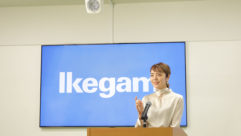
Technology Showcase: Document Cameras
Sep 1, 2008 12:00 PM,
By Jay Ankeney
The latest models have evolved into multifaceted communication tools.

Qomo HiteVision QD6100SX
There’s a scene from the WWII spy movie 5 Fingers where über-suave James Mason, code-named “Cicero,” pulls a tiny Minox camera out of his jacket to snap copies of top-secret diplomatic messages in the British embassy. Now that was a document camera.
But over the ensuing years, the term “document camera” has evolved considerably. With celluloid film long superseded by electronics as a means of conveying their images, the idea of a document camera came to reside in webcams that were employed as a replacement for overhead projectors to let presenters show papers and objects to their audience.
Early document-camera models that appeared in the ’70s consisted of a still, black-and-white analog videocamera flanked by a couple of lights shining onto a surface of the viewing area beneath the camera. Notes could be scribbled on the paper that was sitting on the illuminated surface to accompany the image on the wall, but that was about it. The result? Boredom.
The problem was the image was not distinct enough to be a substitute for seeing the real thing if a 3D object was involved. And seeing a piece of paper projected on a wall was like, well, seeing a piece of paper on a wall.
But with the advent of digital imaging and high-resolution cameras matched by HDTV displays, excitement has once again entered the document-camera arena — except they are rarely called “document cameras” anymore.
Today, they are most often referred to as “visualizers,” “object display stands,” or “presenters,” among other terms. They can range from a 3lb. ultra-portable model to a 30lb. conference-room unit. Although they can function by themselves, modern document cameras are often used as integrated components of interactive-whiteboard presentations.
The cameras themselves are increasingly benefiting from high-definition resolutions in the higher-end versions and trending toward moving-video capabilities. Some are even offering realtime 30fps motion images in full-HD 1080p. When interfaced with the information resources of a computer that is linked to the Internet, these photo-optic devices that allow a presenter to put an image of the object under discussion up onto a big screen in front of an audience can lend significant punch to any presentation.
Thanks to support from government funding, the major market for today’s implementation of document cameras is in education. A growing number of corporate training centers, auditoriums, and boardrooms are also adopting this communication tool for local presentations and for multisite broadcast to facilities anywhere their secure networks or the Internet can reach. Here is a look at some of the most innovative progeny of a technology that started as a simple document camera and has evolved into a multifaceted adjunct to realtime, audience-involving communication.
The AVerVision SPB370 from AVerMedia can output 1080p full-HD images from its complementary metal-oxide semiconductor (CMOS) 5-megapixel color sensor through a 20X Aver Optical Zoom. This combines an 8X optical zoom with 2.5X AVerZoom while still maintaining the ability to pan. The IP-network-addressable capability of the AVerVision SPB370 enables users to connect and view live visualizer presentations from virtually any location where Internet access is available. It includes an 8”×10” light box; dual VGA output ports for outputting images to two displays; and audio pass-through, thanks to its mic/in and audio/out ports. The software that comes with the SPB370 enables you to annotate, capture images, record video with audio, and control the features and functions of the visualizer. Images can be captured to the document camera’s internal memory, an SD card, a USB flash drive, or directly to a PC or Mac.
1
Technology Showcase: Document Cameras
Sep 1, 2008 12:00 PM,
By Jay Ankeney
The latest models have evolved into multifaceted communication tools.

Dukane Camera 335
The Video Visualizer RE-450X from Canon features XGA (1024×768) resolution, advanced automatic exposure and zoom control, and a 12X zoom. Its twin fluorescent lamps provide uniform light to view even the smallest detail. In addition, the RE-450X has an innovative feature that optimizes the clarity of white paper documents by incorporating a color-corrected light box beneath its base. This feature can also be very handy for viewing slides and transparencies. With the press of a button, a high-quality still image can be temporarily stored in memory and displayed on a projector or monitor. Canon also offers its RE-455X web-camera visualizer using a 850,000-pixel progressive CCD imager with a Canon 12X power zoom lens for XGA output. In its white-paper mode, the RE-455X can lighten the background of documents to a whiter color for easier reading.
The Camera 335 from Dukane boasts a smart gooseneck design to easily direct its XGA-resolution, CCD-based, 20fps digital vision — which benefits from autofocus and a 10X manual zoom. The lens head and light on the Camera 335 can be rotated 360 degrees, and its fluorescent lamp can be also be rotated to avoid glare and shadows. Taking a step up in performance, Dukane’s flatbed DVP505A digital presenter consists of a XGA-resolution color camera on a moveable extendable arm mounted over a stage with a backlight. The DVP505A can record 20fps moving video on an outboard PC or VCR. Dukane’s DVP505A has a 12X optical and 4X digital-zoom range. For sound enhancement, it even has a microphone input that goes to an output for an amplifier and loudspeakers.
Elmo announced its new P30S visual presenter at InfoComm 08. It boasts a highly precise 1,350,000-pixel CMOS image sensor with a horizontal resolution of 800 lines and a specially designed lens that minimizes distortion and light falloff around the edges. With a 16X optical zoom and 4X digital zoom, the P30S is equipped with a USB port for easy image transfer to and from a PC; it can even be used as a 3D scanner. A built-in 3.5in. LCD monitor on the control panel lets operators see what is being projected behind them on the screen. Elmo’s bundled Image Mate software also lets them easily monitor, capture, edit, and save any image to outboard computer storage or an SD card. With a 1280×720 output, the P30S’s progressively scanned images can be seen on a 16×9 HD monitor or wide projector screen. Its zoom and autofocus controls are conveniently concentrated on the camera. Both the camera and its lights can be easily folded down when they are no longer needed.

Epson DC-10s
The P30S also has TWAIN compatibility with the versatility to import saved image files to commercially available photo-retouching software. Although TWAIN is not an official acronym, it has become widely defined as “Technology Without an Interesting Name.” It was actually originally derived from a line in Rudyard Kipling’s “The Ballad of East and West” that contains “…and never the twain shall meet…”
The Epson DC-10s, which the company still calls a document camera, boasts a 14×9 capture area that lets the imager display two full pages side by side to eliminate paper shuffling. With SXGA (1280×1024) resolution at up to 15fps, the Epson DC-10s comes with two built-in LED light sources and 5X digital and 8X manual zoom — which means you can physically move the camera toward the object while everything stays sharp thanks to its autofocus capability. The camera can store more than 300 .jpg images in its 128MB of internal memory, and thanks to its VGA pass-through and S-Video outputs, it can display those images on either a video projector or computer monitor while its internal switcher selects between the two. The SD card slot in the Epson DC-10s means you can present images created offboard without having to upload them to a PC. The unit’s form factor is small enough to be easily carried from boardroom to training center.
2
Technology Showcase: Document Cameras
Sep 1, 2008 12:00 PM,
By Jay Ankeney
The latest models have evolved into multifaceted communication tools.

Samsung UF-130DX
Having grown more than 200 percent in the past three years, Lumens
claims to be the number-one market-share leader in the document-camera
industry. The company’s new DC260 is called “the first generation of
multimedia HD-capable visual presenters,” due to its advanced audio and
video processor and 1080p SXGA output. It features a 3X optical zoom, a
double-lamp design to eliminate hot spots, and a viewing area that can
accommodate two documents side by side. The DC260 can hold up to 240
.jpg images internally, store presentations to an external SD memory
card that supports up to 32GB memory, or transfer them to a Windows or
Mac computer with a USB 2.0 high-speed connection. The DC260’s built-in
slideshow capability can play back images and video clips directly to a
connected HDTV, PC monitor, or projection screen. The DC260 is
available with a 22in. extended gooseneck to capture larger or
wide-angle subject matter. It also boasts a patent-pending Half-page
mode to toggle the captured page from the full-page view to the top
half of the page, so viewers can see it in larger print without the
presenter having to move the actual paper.
In response to its customers’ requests, Qomo HiteVision
has designed its new QView QD750 digital-processing document camera
with all the advanced features of the company’s popular QD700 and added
an articulated, rotating camera head that lets you move the camera in
almost any direction or angle. (The name “Qomo,” by the way, comes from
the Tibetan name for Mount Everest.) With a 22X optical zoom and the
same 30fps XGA 4×3 video performance as its predecessor, the QD750 can
access a high-speed USB 2.0 port for video/image capture on both a PC
and a Mac. Its two RGB inputs and two RGB outputs provide installation
flexibility and convenience; its arm and base LED lights are
eco-friendly, are cool to the touch, and can last for 10 years. For
widescreen presentations up to SXGA and WXGA, Qomo’s new QView QD6100SX
also has a motorized camera head, internal storage of up to nine
high-resolution images, and built-in multi-media switching and control
functions. You can connect two Mac computers or PCs (with audio), a DVD
player, and a VCR directly to the QD6100SX with just one VGA cable to
connect to your display device or projector.
Samsung is proud to say its new document camera that
was just introduced at InfoComm 08, the UF-130DX, is not just a digital
presenter. It’s the first visualizer system with Windows CE software
onboard (an embedded compact version of Microsoft’s Windows operating
system), making it a complete presentation station all by itself. This
enables users to upload their presentations directly to the digital
presenter from CompactFlash cards, SD cards, or even USB flash drives.
The UF-130DX is also networkable via Ethernet 10/100. With 720p HD
output as well as standard XGA and SXGA resolutions at 30fps, it
includes a new power LED optical lamp system for even, glare-free
illumination. The UF-130DX includes Samsung’s high-quality optics, fast
autofocus capabilities, and enhanced color accuracy. A very powerful
feature of the UF-130DX is the ability to provide live, dual outputs
from the document camera as well as the input source. That enables
these live displays to be sent to multiple monitors for side-by-side
viewing or to be overlaid on a single display for picture-in-picture
viewing.
Smart Technologies, a leader in interactive whiteboard
systems, also offers the Smart Document Camera, model SDC-280, with a
1/3in. progressive-scan CCD imager in a rotating camera head that
produces XGA (1024×768) RGB resolution output at 20fps. Combining 5.2X
optical zoom and 8.0X digital zoom with LED illumination, the SDC-280
can also automatically focus your images and adjust the brightness for
varying light levels. The SDC-280 comes with version 10 of Notebook
software. Notebook 10 enables you to control the camera, capture images
directly onto a Notebook page, and write over those pages in digital
ink. The unit comes equipped with a microscope interface for optical
microscopes that are less than 13 1/10in. (33.3cm) tall.
Toshiba has taken a unique approach to document
presentation by building a visual-presenter camera right into an LCD
projector, resulting in the TLP-XC2500AU. Its integrated CMOS document
camera has 3-megapixel XGA resolution and features Toshiba’s enhanced
Natural Color Enhancer3 (NCE3), which makes LCD images exceptionally
vivid even at 2500 ANSI lumens. It also has one-touch autosetup by
using its powerful presentation remote and automatic vertical keystone
correction (±30 degrees) that instantly projects a square image even
when the projector is set up at a steep offset angle to the screen. The
TLP-XC2500AU also features a sophisticated approach to security thanks
to a removable palm-sized control panel. When the control panel is
removed, the projector cannot be operated unless the password is
entered on the remote control.
Toshiba also offers its 2000-ANSI-lumen TLP-XC2000U projector with an
integrated CMOS document camera that weighs only 8.8lbs. It features a
special monitor-out capability that allows the user to display and view
images on a monitor and screen simultaneously so the presenter can face
the audience directly rather than turning around to read slides.
As one of the leaders in high-end visual-presentation systems, WolfVision
offers portable desktop and ceiling designs. The company’s VZ-C122 and
VZ-C32 ceiling visualizers, for example, are the third generation of
WolfVision ceiling visualizers. They are intended to prevent the
presenter’s own shadow from blocking the screen. Because they are
mounted on the ceiling, the VZ-C122 and VZ-C32 offer a larger pick-up
area than desktop units. The VZ-C122 and VZ-C32 are equipped with new
telezoom lenses that have an extended zoom range of 64X (16X optical
plus 4X digital) to permit installation in rooms of nearly any ceiling
height. However, while the VZ-C122 has a 1CCD camera, the VZ-C32 boasts
a 3CCD imager with 1,000 lines of resolution at 30fps. The output
signal and the synchronized lightfield of the VZ-C32 and VZ-C122 can be
switched between 4:3 and 16:9 aspect ratios.
All of WolfVision’s desktop presenters now provide SXGA resolution in a
true 720p HD format. For example, its VZ-57plus professional visualizer
has a unique light system that greatly improves the overall picture
quality; this is especially true when working with 3D objects because
it allows for shadow-free illumination, illumination of hollow objects,
and exceptional depth of focus. The motorized arm and mirror of the
VZ-57plus desktop visualizer allow convenient scrolling of documents
with the system’s sophisticated remote control.
MORE INFORMATION
AVerMedia
www.aver.com
Dukane
www.dukcorp.com
Elmo
www.elmousa.com
Epson
www.epson.com
Lumens
www.mylumens.com
Qomo HiteVision
www.qomo.com
Samsung
www.samsungpresenterusa.com
Smart Technologies
www.smarttech.com
Toshiba
www.toshiba.com
WolfVision
www.wolfvision.com
3









